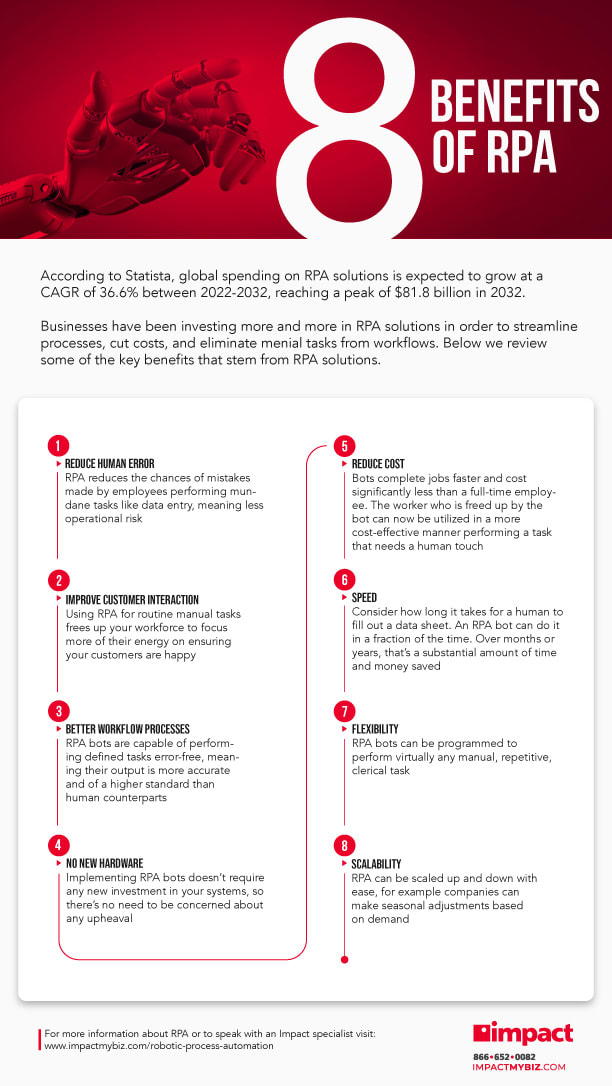RPA is on the rise across every industry. Find out 8 benefits of robotic process automation that are leading SMBs to invest in this technology!
Big manufacturing plants using robots to design and assemble products is one of the first things I think of when I hear the word automation. However, this is really just one use-case for automative technology and doesn’t apply to many businesses. Robotic process automation (RPA), however, is a much more universal technology that businesses rely on regardless of size and industry.
Simply put, robotic process automation makes use of automative technologies to cover recurring tasks that can be time consuming but not necessarily high-value in nature. Data entry tasks, for example, offer a perfect use case for RPA solutions.
By implementing RPA technologies into your workflows, you can streamline processes, cut costs, and free up valuable employee time to focus on more critical tasks. Review the infographic and the sections below for a comprehensive look into RPA solutions and the benefits they offer.
- Reduced Errors
- Improved Customer Experience
- Better Workflows
- No Hardware Necessary
- Cost Reduction
- Time Savings
- Flexibility
- Scalability
RPA solutions can help you streamline workflows while saving both time and money, discover how you can further improve your operations in Impact’s Webinar, How to Identify High-Value Opportunities for Innovation!
1. Reduced Errors
RPA mitigates the risk of human error by executing tasks with precision and consistency. Whether it's data entry, reconciliations, or simple process checks, RPA bots follow predefined rules meticulously, minimizing the likelihood of inaccuracies or oversights.
This heightened accuracy not only enhances data quality but also ensures regulatory compliance, particularly in industries with stringent governance requirements such as finance and healthcare. By automating error-prone processes, organizations can bolster operational efficiency, avoid costly mistakes, and maintain trust with stakeholders.
2. Improved Customer Experience
Robotic process automation revolutionizes customer-facing operations by streamlining processes and enhancing responsiveness. In turn, this substantially enhances the customer experience.
From order processing and billing to customer inquiries and issue resolution, RPA accelerates the delivery of services, leading to faster turnaround times and higher satisfaction levels. By automating routine tasks, customer service representatives can devote more time to addressing complex queries, providing personalized assistance, and nurturing customer relationships.
This improved efficiency translates into a seamless and delightful customer experience, fostering loyalty and advocacy for the brand.
3. Better Workflows
RPA optimizes workflows by automating repetitive tasks and orchestrating seamless interactions between disparate systems. By removing bottlenecks and reducing manual intervention, RPA accelerates task completion times, increases throughput, and minimizes operational friction.
Employees are liberated from mundane tasks to focus on high-value activities that require creativity, problem-solving, and critical thinking. This redistribution of resources not only boosts productivity but also cultivates a culture of innovation and continuous improvement within the organization.
4. No Hardware Necessary
Unlike traditional automation solutions that often require substantial investments in hardware infrastructure. In short, RPA operates within existing software environments, leveraging APIs, user interfaces, and backend systems.
This software-centric approach eliminates the need for specialized hardware or infrastructure upgrades, reducing upfront expenses and simplifying deployment. Organizations can leverage their existing technology stack to implement RPA solutions quickly, accelerating time-to-value and maximizing the return on investment.
5. Cost Reduction
RPA solutions also drive significant cost savings by automating labor-intensive processes, reducing manual errors, and optimizing resource utilization.
By replacing repetitive tasks with software robots, organizations can achieve operational efficiencies and economies of scale, resulting in lower labor costs and higher productivity levels. Additionally, RPA enables workforce scalability, allowing organizations to scale operations up or down in response to fluctuating demand in a cost friendly manner.
This cost-effective automation strategy enables organizations to allocate resources strategically, invest in innovation, and maintain a competitive advantage in dynamic markets.
6. Time Savings
Robotic process automation empowers organizations to reclaim valuable time by automating time-consuming and high-volume repetitive tasks across various business functions.
Whether it's data entry, report generation, or invoice processing, RPA bots operate 24/7, executing tasks with unmatched speed and accuracy. This accelerated output translates into faster turnaround times, reduced lead times, and improved service levels.
By automating routine tasks, organizations can reallocate human resources to high-value initiatives, accelerating innovation, and driving business growth.
7. Flexibility
Robotic process automation offers unparalleled flexibility in adapting to evolving business requirements, process changes, and technology landscapes.
Unlike traditional IT projects that require extensive coding and development efforts, RPA solutions are designed to be configurable, agile, and non-intrusive. Bots can be easily reprogrammed, scaled, or repurposed to handle new tasks, integrate with different systems, or accommodate regulatory changes.
This flexibility enables organizations to respond swiftly to market dynamics, seize emerging opportunities, and stay ahead of the competition.
8. Scalability
Lastly, RPA solutions are inherently scalable, allowing organizations to expand automation initiatives across departments, processes, and geographies as needed.
Whether deploying a few bots to automate a specific process or scaling up to hundreds of bots to transform entire business functions, RPA platforms can accommodate growth without compromising performance or reliability.
This scalability ensures that organizations can scale their automation efforts in alignment with business objectives, evolving customer demands, and market dynamics, driving sustainable growth and operational excellence.
Wrapping Up on the Benefits of RPA Solutions
Understanding how to implement modern technologies into your current workflows will help you build a culture of continual improvement in which you’re always working to better internal operations. Integrating robotic process automation solutions is a great way to start evolving workflows because of how easy they are to adopt regardless of your current tech-stack.
By using RPA solutions, your organization can effectively build stronger workflows that scale with your business, save employees time, and cut costs.
If you want to improve or modernize your operations but don’t know where to start, check out Impact’s webinar, How to Identify High-Value Opportunities for Innovation!
Andrew Mancini is a Content Writer for Impact and DOT Security’s in-house marketing team, where he plans content for both the Impact and DOT Security insights hubs, manages the publication schedule, drafts articles, Q&As, interview narratives, case studies, video scripts, and other content with SEO best practices. He is also the main contributor on a monthly cybersecurity news series, The DOT Report, researching stories, writing the script, and delivering the report on camera.





